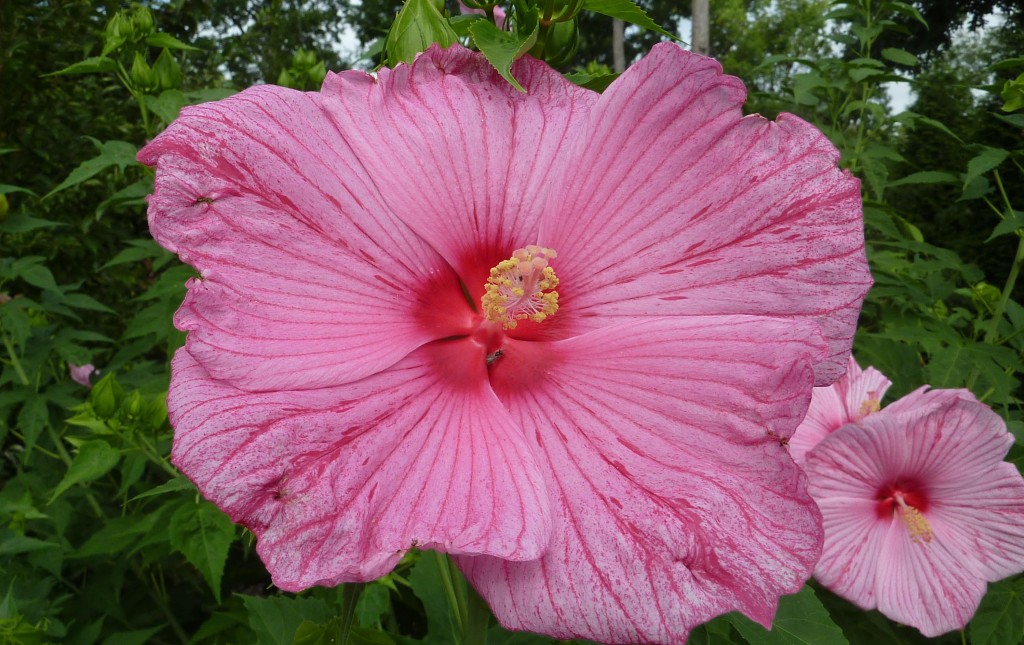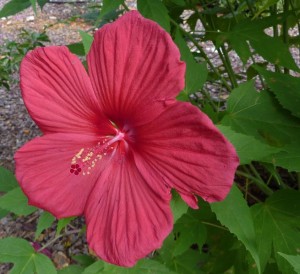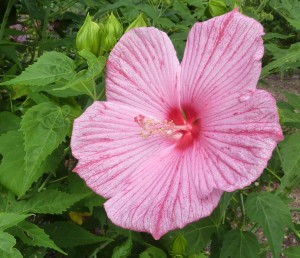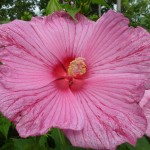Hardy Hibiscus

When most people think of hibiscus (Hibiscus), they think of the Chinese
Hibiscus (Hibiscus rosa-sinensis). It is the most popular and well-known
with its large, bright red flowers and attractiveness to hummingbirds. They
are often grown as ornamental houseplants and can only be grown outdoors in
USDA zones 9a through 10b. They require full sun and are often a hassle to
maintain, having absolutely no tolerance for cold. Unbeknownst to many,
there are also non-tropical varieties of hibiscus that can make it through
winter as far north as zone 4, commonly referred to as Hardy Hibiscus. This
group of plants includes Hibiscus moscheutos, Hibiscus coccineus, Hibiscus
laevis, Hibiscus palustris, Hibiscus grandiflorus, and numerous crosses and
hybrids of each. Most hybrids have been derived from the Swamp-rose Mallow
(H. moscheutos), which grows naturally from Florida to southern Canada.
 All hibiscus look similar at a glance and are in the mallow family. There
All hibiscus look similar at a glance and are in the mallow family. There
are several hundred species that grow throughout the world. Tropicals have
glossy, dark green leaves while the hardy hibiscus have duller, medium green
leaves. Hardy Hibiscus flowers are actually larger and the famous dinner
plate-sized blooms belong to the hardy varieties, but all have five petals
and are trumpet-shaped. Hardy Hibiscus also have two to four-inch
bomb-shaped buds.
Hardy Hibiscus are versatile perennial shrubs, growing three to ten feet
tall, depending on the variety. They tolerate full to partial sun and any
well-draining soil, including sand. Once established, most will grow with no
special treatment whatsoever. They are easy to propagate with seeds They are
easy to trim down and can be used as groupings, hedges, borders, and
specimens. They all feature the popular large flowers, up to a whopping
twelve-inches across, with colors from white to pink to red and even purple
and blue. Only tropical species come in salmon, peach, orange, and yellow.
The blooms last only one day each, but then more bloom the following day for
months at a time, creating more than a hundred blooms per flowering season.
The only significant problem that these hibiscus face are Japanese Beetles,
which will make a mess of the flowers and leaves.
 One thing you must do is resist the temptation to cut the stems back after
One thing you must do is resist the temptation to cut the stems back after
the plant has been hit by cold. The stems are hollow and should be left up
over the winter and cut down in the spring after the danger of frost has
passed. If you cut the stems down to the ground in the fall or winter, you
run the risk of water flowing from the stems to the root stock causing the
root stock to freeze and killing the plant.


